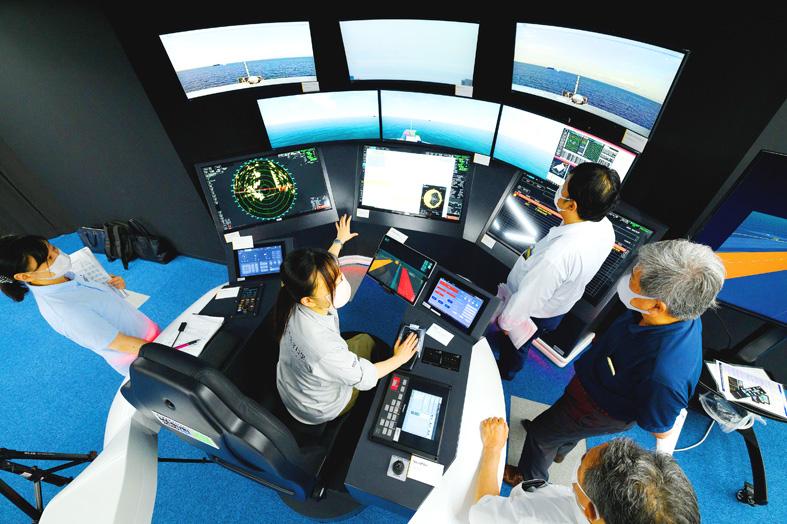In just two decades from now, half of all domestic ships plying Japan’s coastal waters might be piloting themselves.
That is the ambitious goal of the Nippon Foundation, a public interest organization backing the nation’s development of ocean-traversing autonomous ships. It aims to see crewless ships make up 50 percent of Japan’s local fleet by 2040.
With the foundation’s backing, a group that includes Japan’s largest shipping company, Nippon Yusen KK, plans to have a container ship pilot itself from Tokyo Bay to Ise, a coastal city in central Mie Prefecture, in February next year.

Photo: Bloomberg
According to Nippon Yusen, the 380km voyage would be the world’s first test of an autonomous ship in an area with heavy marine traffic.
The global market for autonomous shipping could grow to be worth about US$166 billion by 2030.
“When it comes to the automation of ships, our mission is to have Japan lead the rest of the world,” Satoru Kuwahara, a general manager at Nippon Yusen subsidiary Japan Marine Science Inc, said in an interview on Thursday.
Kuwahara, a captain himself, said there is a real need for autonomous ships in Japan as the country’s workforce shrinks and rapidly ages. In the nation’s domestic tanker industry, for example, about 40 percent of crew are 55 years or older, according to a recent survey.
The Nippon Foundation estimates that taking into account factors like artificial intelligence, which should improve efficiencies, the development of unmanned ships would have a positive impact of about ¥1 trillion (US$9.1 billion) for Japan’s economy in 2040.
There are other foreseeable benefits too, such as lower insurance premiums and improved safety, Kuwahara said.
Studies on shipping industry safety show that about 70 percent of maritime accidents are caused by human error.
“With the issue of Japan’s shrinking workforce in mind, there’s growing need for these technologies to uphold safety,” he said.
For the February test run, information on everything from weather to radar data points would be collected and crunched at a support center back on land. Directions would then be fed back to the ship. In the case of an upset, the vessel’s steering can be taken over remotely from the center.
Kuwahara said he is confident such technology would be ready to be put into practical use by 2025.
The “immense challenge” would be developing a regulatory environment and industry standards around autonomous shipping by then, he said.
For now, Kuwahara and others are gearing up for next year’s trial run, running simulations at a technology center east of Tokyo.
“We need this technology to be recognized, otherwise actual implementation in society won’t move forward,” Kuwahara said. “As a first demonstration, we can’t fail.”

China’s Huawei Technologies Co (華為) plans to start mass-producing its most advanced artificial intelligence (AI) chip in the first quarter of next year, even as it struggles to make enough chips due to US restrictions, two people familiar with the matter said. The telecoms conglomerate has sent samples of the Ascend 910C — its newest chip, meant to rival those made by US chipmaker Nvidia Corp — to some technology firms and started taking orders, the sources told Reuters. The 910C is being made by top Chinese contract chipmaker Semiconductor Manufacturing International Corp (SMIC, 中芯) on its N+2 process, but a lack

TECH BOOST: New TSMC wafer fabs in Arizona are to dramatically improve US advanced chip production, a report by market research firm TrendForce said With Taiwan Semiconductor Manufacturing Co (TSMC, 台積電) pouring large funds into Arizona, the US is expected to see an improvement in its status to become the second-largest maker of advanced semiconductors in 2027, Taipei-based market researcher TrendForce Corp (集邦科技) said in a report last week. TrendForce estimates the US would account for a 21 percent share in the global advanced integrated circuit (IC) production market by 2027, sharply up from the current 9 percent, as TSMC is investing US$65 billion to build three wafer fabs in Arizona, the report said. TrendForce defined the advanced chipmaking processes as the 7-nanometer process or more

NVIDIA PLATFORM: Hon Hai’s Mexican facility is to begin production early next year and a Taiwan site is to enter production next month, Nvidia wrote on its blog Hon Hai Precision Industry Co (鴻海精密), the world’s biggest electronics manufacturer, yesterday said it is expanding production capacity of artificial intelligence (AI) servers based on Nvidia Corp’s Blackwell chips in Taiwan, the US and Mexico to cope with rising demand. Hon Hai’s new AI-enabled factories are to use Nvidia’s Omnivores platform to create 3D digital twins to plan and simulate automated production lines at a factory in Hsinchu, the company said in a statement. Nvidia’s Omnivores platform is for developing industrial AI simulation applications and helps bring facilities online faster. Hon Hai’s Mexican facility is to begin production early next year and the

Who would not want a social media audience that grows without new content? During the three years she paused production of her short do-it-yourself (DIY) farmer’s lifestyle videos, Chinese vlogger Li Ziqi (李子柒), 34, has seen her YouTube subscribers increase to 20.2 million from about 14 million. While YouTube is banned in China, her fan base there — although not the size of YouTube’s MrBeast, who has 330 million subscribers — is close to 100 million across the country’s social media platforms Douyin (抖音), Sina Weibo (新浪微博) and Xiaohongshu (小紅書). When Li finally released new videos last week — ending what has